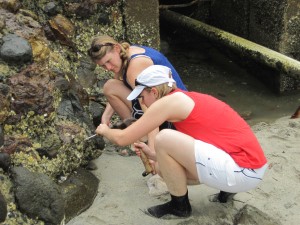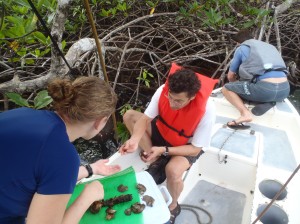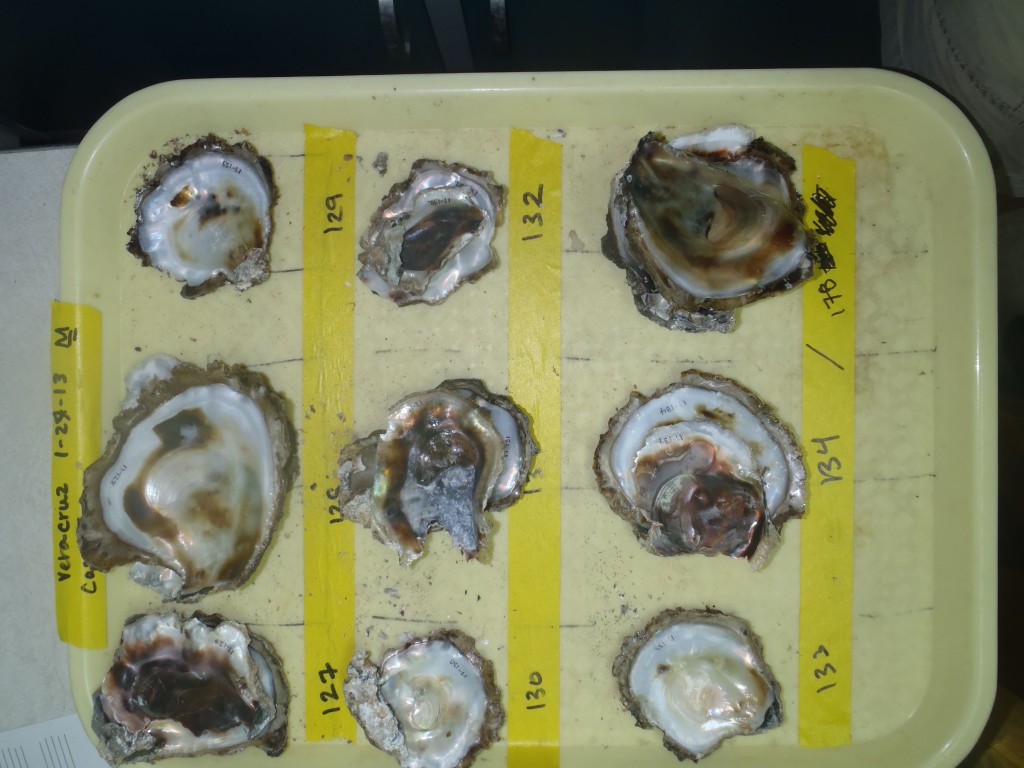by Monaca Noble and Katrina Lohan

Oysters and other life grow on dock pilings at the Smithsonian Tropical Research Institute in Panama
(Kristina Hill-Spanik)
A robin is a robin. It isn’t often confused with other birds. But some marine organisms are very difficult to identify because they look similar, too similar even for taxonomists trained to detect differences. Oysters are like this.
Oyster shells come in all shapes and sizes. As oysters fight for space and battle to survive in tough environments, their shells can change appearance based on conditions where they live. This makes it very hard to distinguish similar-looking species. Using DNA, we can identify these difficult species and provide new insights into their distribution, ecology, and ranges—insights not possible using shell morphology alone. In Panama, this DNA detective work led to two surprising discoveries.

Katrina Lohan (front) and Kristina Hill-Spanik collect oysters in Punta Chame, Panama. (Carmen Schlöder)

Kristina Hill-Spanik, Mark Torchin and Greg Ruiz collect oysters off mangrove roots. (Katrina Lohan)
Dr. Katrina Lohan of the Smithsonian Environmental Research Center, along with Kristina Hill-Spanik, Dr. Mark Torchin, Dr. Ellen Strong, Dr. Robert Fleischer, and Dr. Greg Ruiz, used a combination of morphological and molecular data to determine the distribution of oysters in Panama. The team collected oysters from three regions along the Panama coastline: near the Panama Canal on the Caribbean side, near the Canal on the Pacific side, and in the Bocas del Toro archipelago, more than 150 miles from the Canal’s Caribbean side. They identified 10 bivalve species and made two unexpected finds:
First, the eastern oyster (Crassostrea virginica) appeared on the Caribbean side of Panama, in close contact with another closely related species, the mangrove oyster (C. rhizophorae). Second, a non-native species of oyster, the hooded oyster or Natal rock oyster (Saccostrea “cucullata”) from the Indo-Pacific Ocean, popped up in multiple locations along the Caribbean coast of Panama. Neither oyster had ever been seen in Panama. The team detailed their discoveries in the journal Marine Biology.
In the past, the oysters of Panama haven’t received much attention from scientsts. But the Panama Canal creates the opportunity for new species to arrive on commercial ships from around the world—hence the interest of Dr. Lohan and her colleagues. Many oyster species have widespread and overlapping geographic ranges because they are very good at spreading, through both natural and human-mediated methods. Some have long-lived planktonic (waterborne) larvae. They also can settle on floating debris and the hulls of vessels, and can be moved by aquaculture stocking and in the ballast water of ships. Combined, all these give the oysters countless chances to spread over great distances. Dr. Lohan speculated that the hooded oyster was likely introduced by shipping or boating activities, though she can’t say for certain how or when without more evidence.
Adding to the mystery: The hooded oyster may not even be a single species. Its species name, “cucullata,” is in quotes because current data indicate it may represent a “species complex,” meaning multiple species are being called by the same name. Because oysters are hard to identify without molecular data, closely related species are often grouped together in reports and literature. When we talk about the geographic distribution and habitat of Saccostrea “cucullata,” we have to include all the similar species lumped together under the same name. Returning to the bird analogy, flycatchers are an example of a species complex. Willow, alder, and other similar flycatchers are very hard to tell apart, because they differ mainly by song and habitat. At least four species of flycatcher on the East Coast of North America have been grouped together under a single name in older guidebooks, and individual species have been misidentified in museum collections. Based on current molecular data, the hooded oyster may actually be seven different oyster species.

Old school: Scientists use cafeteria trays to keep track of all the different oysters. (Kristina Hill-Spanik)
Molecular data is helping resolve these species complexes and separating sister species, like the physically similar eastern oyster (Crassostrea virginica) and mangrove oyster (Crassostrea rhizophorae). Like flycatchers, these two oyster species were identified and separated by geographic range and habitat preference. People once thought that (a) the eastern oyster primarily formed reefs or settled on hard substrates in the intertidal and subtidal waters from the Gulf of Mexico to Canada and (b) the mangrove oysters live on the roots of mangrove trees from the Caribbean Sea to Brazil. We now know that eastern oysters are in the Caribbean waters of Panama, where these species co-occur in the same habitat, since the team found both species growing on the roots of mangrove trees.
Combining morphological and molecular data provides the tools to identify 10 different bivalve species with relative certainty and to determine with confidence that at least one was introduced to Panama. This research clearly shows that one method alone wasn’t enough to determine the difference between mangrove oysters and eastern oysters. Surprisingly, even for large marine animals like oysters, which are conspicuous and well-studied in coastal bays and estuaries around the world, there are still many unanswered questions to explore.
Read more about Katrina Lohan and the Marine Invasions Lab’s adventures in Panama:
From the Field: Hunting for Parasites
From the Field: Finding Oysters in Panama
From the Field: Two Weeks in Panama

